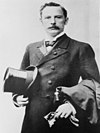1894 Costa Rican general election
| |||||||||||||||||||||||||||||||
| |||||||||||||||||||||||||||||||
| |||||||||||||||||||||||||||||||
The 1894 Costa Rican general election was held between 4 and 6 of February (first degree) and 1 April of that year (second degree). The election was quite controversial due to the questionable practices from the government of José Joaquín Rodríguez Zeledón who supported his son-in-law Rafael Yglesias using all sorts of measures to assure his victory, going as far as to even arrest his main rival.[3]
In the previous election Rodríguez won thanks to the endorsement of the Catholic Church and the up to that point marginalized conservatives over liberal and freemason Ascensión Esquivel Ibarra.[4] However, the intent of the then liberal government of Bernardo Soto Alfaro of almost reject the results and appoint Esquivel anyway almost caused a Catholic uprising. Ironically, this date is commemorated in Costa Rica as "Democracy's Day".[5]
After the victory, Rodríguez' party, the Constitutional Party broke away forming two new parties; the ultra-Catholic, conservative and anti-Masonic Catholic Union led by Costa Rican bishop of German origin Bernard Thiel, and the loosely liberal Civil Party led by Rodriguez' son-in-law Yglesias.[3] Rodriguez used all sorts of pressures and trick against Trejos, pressuring the Electoral College (as at the time Costa Rican elections were indirect) and forcing the results in favor of his relative. Soon after Yglesia's victory the Constitution was amended forbidding the existence of religious-based parties, thus making Catholic Union illegal.[3]
Results[]
Second grade electors, original estimate
Original estimate by the "Prensa Libre"
| Candidate | Party | According to the "Prensa Libre" | According to "El Heraldo" | |
|---|---|---|---|---|
| José Gregorio Trejos | Catholic Union | 318 | 321 | |
| Rafael Yglesias Castro | Civil | 180 | 190 | |
| Manuel de Jesús Jiménez | Party of the People | 80 | 75 | |
| Félix A. Montero Monge | Independent Democratic Party | 70 | 70 | |
| - | Unbound electors | 15 | 7 | |
| Total | 663 | 663 | ||
| Source:[6] | ||||
Actual results
| Province | Yglesias | Trejos | Montero | Gutiérrez | ||||||
|---|---|---|---|---|---|---|---|---|---|---|
| 52 | 86 | 29 | - | |||||||
| 117 | 5 | 9 | - | |||||||
| 11 | 54 | 14 | - | |||||||
| 45 | 18 | 6 | - | |||||||
| 57 | 9 | - | - | |||||||
| 3 | 15 | - | 15 | |||||||
| 13 | 1 | 4 | - | |||||||
| Total | 298 | 188 | 62 | 15 | ||||||
| Source:[7] | ||||||||||
References[]
- ^ Obregón, Clotilde (2000). El proceso electoral y el poder ejecutivo en Costa Rica: 1808-1998. TSE. ISBN 9789977676180. Retrieved 29 December 2018.
- ^ Tribunal Supremo de Elecciones de Costa Rica (2008). "Historia de las elecciones presidenciales 1824-2006" (PDF). Archived from the original (PDF) on 2016-03-04. Retrieved 2018-12-21. Cite journal requires
|journal=(help) - ^ a b c Di Luca, Clara (1977). El Partido Unión Católica; primer partido ideológico de Costa Rica.
- ^ González, Daniel (2014). "Los partidos políticos en Costa Rica: un acercamiento histórico". Boletín de la Asociación Para el Fomento de los Estudios Históricos en Centroamérica. 60. Archived from the original on 2018-12-20. Retrieved 2018-12-21.
- ^ Tribunal Supremo de Elecciones. "Celebración del 7 de noviembre: Día de la Democracia Costarricense". Retrieved 20 December 2018.
- ^ Salazar, O. (2003) El apogeo de la República Liberal en Costa Rica, 1870-1914, p 186 ISBN 9977-67-131-1
- ^ Salazar, O. (2003) El apogeo de la República Liberal en Costa Rica, 1870-1914, p 188 ISBN 9977-67-131-1
- Elections in Costa Rica
- 1894 elections in Central America
- 1894 in Costa Rica


